|
To give you some background on kites as lifters, the
weather services have made extensive
use of kites for lifting weather instruments in the past. The British Antarctic
Survey uses kites and Helikites for taking climatic measurements
also. The golden era of lifter kites was in the period from
1880 to 1920. Large kites were tested for man lifting in the same
period, for applications like military observers. Then they invented the
airplane.
Versions of the winged box kite was the champion in all cases in the late
19th and early 20th centuries.
But that was before the Para Foil kites were invented. The standard for
the weather services was a box kite called the Meteorological Box Kite. It had a rectangular section when viewed
from the front.
Today, there are many special kite stores, so you are not limited to
what you can build from plans in books, or the cheap paper
diamond kites we used as kids.
|
The Classic Box Kite was a payload lifting standard at the turn of the last century. It was considered by some hard to fly. Some of the variations
included a tetrahedron shaped box kite, but it is mostly
good looking, not a good lifter like the classic box
kite. One of my 'Odd Box Kites' used occasionally for antenna service is shown here, and it is called the
Rhombic Box. Very stable, not too good in high winds, but anyone
can fly it. You can just see my French Military kite in the
background. More on it later.
|
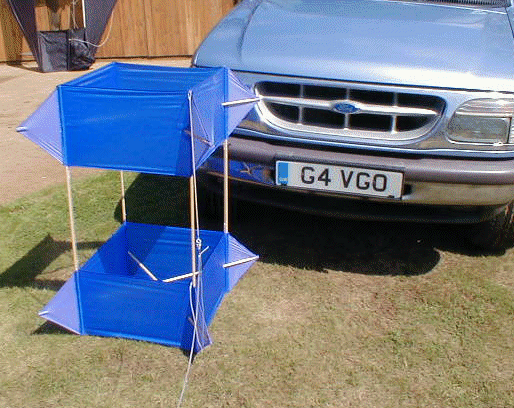
|

One of the
most famous 'man lifting' kites was a several-celled box
kite with small wings, the Cody War Kite. I have several
Cody War Kites of various sizes and sizes. They really are beautiful once in the
air. Any wind speed below 8 mph and the Cody will just not fly.
Here is a colourful example of one in flight. I also have large Cody
kites in black and red. For antenna lifting, they are hard to beat
plus they are beautiful to behold! I sometimes fly a train of three
of them, and have had that configuration up to over a thousand feet. 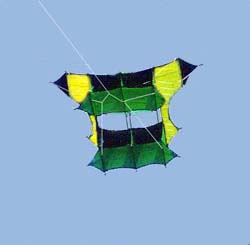

Another
possibility, and one that I have used in the past, is the previously
mentioned Para Foil. Again, I have a few and they are a real attention-grabbing flying object. 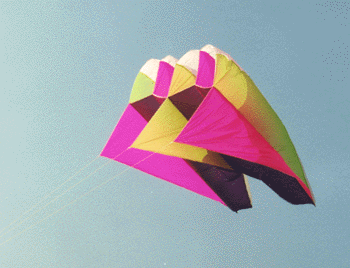
A commercial company makes four
sizes usually available. The sizes are rated in square
feet of area and go from pocket size to a bit less than
four feet wide and a bit less than five feet from front
to back. They are attractive because they fly at higher
string angles than the box kites, more vertical. They
pull like a like a huge sailfish, with the largest size recommending
250 pound test flight line. They wad up into a small duffle bag so that
they are very easy to transport, since they have no
sticks or spars. But, you can't trust them unattended overnight as
an antenna lifter. They also tend to drop like a rock if the wind
hesitates at all. I have used them portable with good results in
Argentina, Israel, and in Sweden. A medium sized one will lift a full
quarter wave of number 20 wire for Top Band and if the winds are steady, it
makes a good lifter for expeditions as it comes in an almost pocket sized
pouch.

|
For taking high altitude measurements in the past, the U.S. Weather Service settled on the "French
Military or Rescue Kite", a triangular winged box kite, shown below. This model is
over six
feet high and really is stable in all kinds of winds. I have used this many
times and it is probably the best kite in my collection for lifting
antennas in a variety of conditions. The kite is
like a classic box kite, but only with three sides to the box
instead of four. It also has dihedral wings added to one
surface which greatly increases its side to side stability. The
Weather Service flew trains of these kites to increase lift and
stability since they sampled air at multiple levels, much like
space diversity receiving. One such train of kites was flown to
27,000 feet! The pull was so great that these trains of large
kites were flown on piano wire, a very dangerous practice for the
amateur.
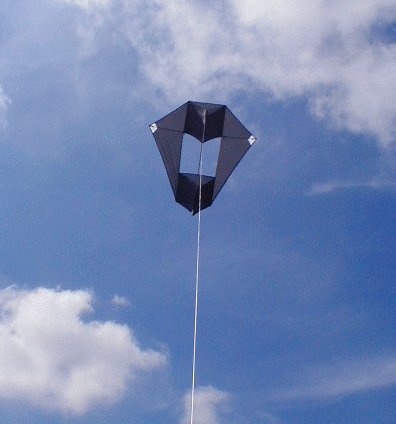
| Below is my "French
Rescue or Military Kite" ready to launch with about 80 feet of 150 pound line
attached to the kite, the antenna which uses 300 pound line as its support
is then attached to that initial drop from the kite bridle. With a bit more than a quarter
wave of antenna on 160 metres, and the additional 80 feet at the top, it will fly in
more laminar winds a bit higher up and stability will increase.
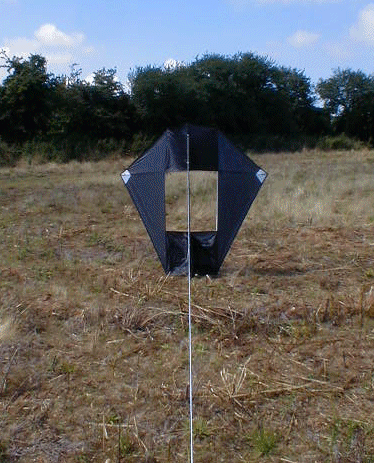

One word of caution that will be repeated throughout these pages, you should
NOT
use the antenna wire as "kite
string", but support the kite with a flying string and attach the antenna
wire to the flying string. A
kite carried away in a wind with a trailing antenna wire is a
dangerous situation. You should make sure that if the kite breaks
free, it cannot take the antenna wire with it. One way of helping
to insure this, is to use a heavier cord below and through the
antenna bearing section, and a lighter cord above, so if the
kite gets loose, it is more likely to break off above the
antenna section. For balloons, if the balloon is flown in light or calm
winds, then sometimes a wire antenna can be the 'flying line'. But,
it is always better to use a support line in addition to the antenna wire.
|
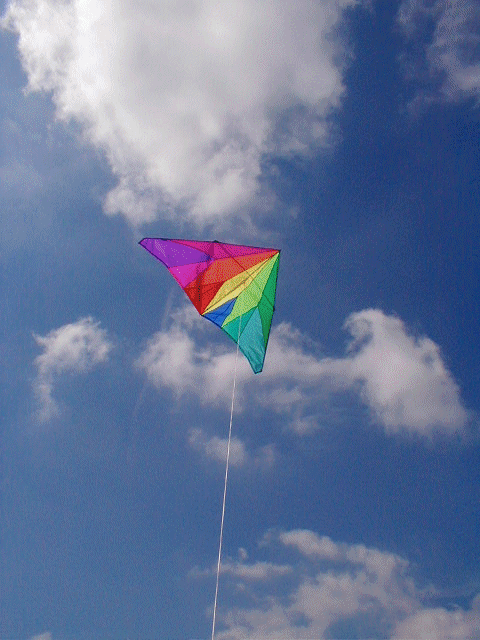
One kite that is popular with those who use airbourne
antennas is the Delta Kite shown above. I have found it to be more trouble
than it is worth as it acts as a hang glider if the wind stops. This
causes the kite to over fly the anchor point, and then when the wind picks
up, it will turn nose first into the ground with some rather disturbing
results. Nice to look at, but not a stable lifter platform in my
opinion. The one shown above is my 12 footer and it does look good, but
like a girlfriend with attitude, a real pain.

| In the past, the weather services were not the only users of kite
lifters. There was a kite used in the original Marconi experiments
more than a century ago.
On December 12, 1901 the first radio signal was transmitted across the
Atlantic from Cornwall, England to St John's, New Foundland. The large
kite was used for the receive site in St. John's. Guglielmo Marconi's
receive antenna lifter is
pictured here.
This is a photo of the kite that lifted the antenna that heard the first
trans-Atlantic signal. The pictured kite is called a Baden-Powell
Levitor, and is very similar to a Rokkaku. The Rokkaku is a Japanese
design, called the Rock for short. Although the original Marconi
receive kite was far from stable, the Rock is a pretty good antenna system lifter and can be purchased from most
large kite shops.
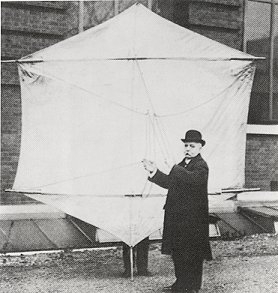


The Rock design above is to be my next kite purchase, as it is
supposed to be one of the best lifters for antennas. After I try one, I'll
put the results on this site.
Finally, before you try to duplicate the Marconi experiments, please consider a 1/4 scale model designed for 40 meters. It
will help you to solve a lot of problems and give you experience at much
less expense and hazard. Anything for 160 meters is just plain BIG. Start
small, get used to handling the kite with an attached antenna, then go for Top
Band.
One last word, if the kite is big or flown high, you can get into
trouble with the Federal Aviation Administration or your local aviation authorities.
60 metres or 200 feet is the vertical height above terrain limit in most countries, and not within
3 miles of
an airport!
|
|
Next
Page, Balloon
Antennas (Page 5)
| |
|
|
|
|







